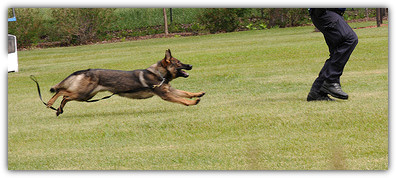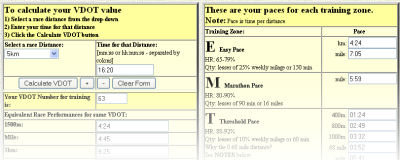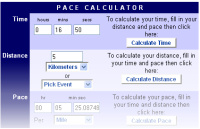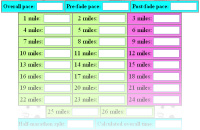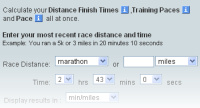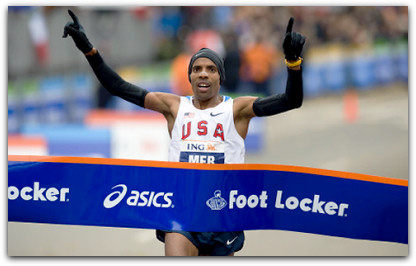August 14th, 2010
It’s exciting new! We now have well over 2,000 members to our running log. I am very happy to see so many people are interested in running and recording their runs. As well it’s great to be able to give back sometime to the running community!
Our member list includes people from all over the world and continues to grow each day. We love seeing more people find our site and help them in there training with our free online tools.
For the future we are planning on adding some more feature to our site in the up coming months. As well as possibly a new design that will make the features and functions (as well as the running log page itself) much easier and fun to use.
In addition we are planning to start making blog posts much more regularly. It’ been a bit off and on in the past but we’re working on getting regular posts being done so as to provide you with tip, advice and news about our site. So if you have any ideas or want to guest post on our blog contact us.
Lastly, as always your comments and suggestions for making our site better are always welcome. And we look forward making our site even more helpful to you!
Posted in Web Related | No Comments »
August 9th, 2010
I recently read an article on Runner’s World about how Michael Ryan (a PH.D. in I believe Sports Medicine) stated “…our current approach of prescribing in-shoe pronation control systems on the basis of foot type is overly simplistic and potentially injurious”. But in reviewing his study I’ve found many issues with how it was conducted.
So lets start with the story, Ryan did a research study with Nike as a sponsor on women half-marathoners during a 13-week training period. They had each women wear a random pair of Nike’s specialized running shoe (ones for flat feet, modest arches, and normal arches) for the entire 13 week study. They then recorded injuries over the course of that time to find who had the lower injury rate. There hypothesis was that “who had randomly received the correct shoes would have a lower injury rate than those who randomly received not-the-right shoes.” The full abstract can be read from Britsh Journal of Sports Medicine
Their results showed that each group received a rather high level of injuries and the ones who received the correct shoes didn’t do any better than the ones who got the wrong shoe for their foot type.
First off after looking over this study the same size is just way too small. Only 81 women were studied. No men where looked at and a study size of that amount is just too small.
Secondly, they only used Nike shoes - thus how do we know if the issue was not just Nike. I personally will get injured if I were Nike shoes to run in even when I select the right shoe for my foot type. No other shoe brands were studied thus further makes this research skewed.
Lastly, where is the control group? Were is the study of the 81 women who wore the “right” shoe for their foot. I’m willing to bet that they don’t have as many injuries. From personal experience as a coach and distance runner for over 18 years I have seen many runners with the wrong shoe have major injury problems and those with the right shoe never have an injury all season.
I think to be fair before we call off prescribing shoes based on foot type and running gate we should do a more accurate study with a more wide range of shoe brands and a much larger sample size. But I do agree there probably could be develop much better shoes and methods for detecting which type of shoe is right for you.
Posted in Injury | No Comments »
August 5th, 2010
With the summer upon us many of us are in climates where the sun is beating down on us pretty hard during our run. So here are some quick tips for dealing with the sun and heat on a run.
- Wear sun block/screen - I know it might not always be the popular thing to do or might take time to put it on but it’s well worth it. What’s better having a sun burn so bad you can’t go out and run or wearing sun screen?
- Stop for water - Stop for water every chance you get. When it’s hot you need more water. Also make sure you’re getting enough salt too - you don’t want to unbalance your water to salt ratio.
- Wear light clothing - If you wear clothing that weights less and will dry quicker this can not only keep you cooler but also prevent you from caring a lot of excess weight due to clothing being soaked from sweat.
- Place water stops - One thing I highly recommended is going out before your run, in your car or whatever, and setting up a water station for yourself. This can really help keep you hydrated.
- Don’t Over Do It - If you’re feeling light headed or any other signs of heat exhaustion then stop. It’s not worth pushing your body past it’s limits and have to pay for it for with several days of no running. Play it safe but run hard at the same time - if that makes sense :).
Posted in Training | No Comments »
June 13th, 2010
One of my biggest nightmares when I run is having a dog or multiples dogs (yes that really bites!) attack me. I’ve had the unfortunate luck of being attacked by not one by two dogs at the same time. Not fun! So what have I learned and how can you prevent yourself from being attacked?
Over the years I’ve discovered that I must be a dog magnet. If there is a dog in the area and it’s lose it will come after me. Maybe it’s the fact that I’m running by fast or it’s just me but I have discovered what works and what does not work in a potential dog attack. In fact I’ve personally had the unfavorable luck of having tested out each of the following methods at various times.
What Does Not Work:
Running Away - this has never really worked for me. I have had dogs bite onto my legs as I’m running (yes, I was dragging the dogs, two of them, while trying to run away)! I mean I can run pretty fast but the dogs always seems to catch up and it seems like this makes dogs more likely to come after me. I guess they see it as a game. There are a few times I have gotten away by doing this but it was only by luck where I sprinted for such a long time the dog and myself were too far from it’s house so it turned back or cars were coming down the road and these stopped the dog enough for me to gain some good distance and it gave up.
Standing Still Like a Tree - this was suggested to me once, as I was told this would stop any dog from attacking me. Boy were they wrong… don’t do this! The dog just keeps charging at you and I’m sure it can smell or tell your fearful of it. You look weak in the dog’s eyes, which leaves you open for the dog to be more aggressive since it things it can easily over power you.
Yell For the Dog’s Owner - Now this is one of the most worthless things I’ve tried. Most of the time the owner will just yell back “it won’t bite” but in my mind I know “…yes, it won’t bite you since it knows you but it doesn’t know me”. Many dogs have been known to bite and you should not listen to the dog’s owner because it’s a dog is an animal and is not totally under the control of the owner or it would not be coming after you in the first place. I’ve sadly had many owners just stand and watch (not doing anything!) as their dogs ran out of their yard and began to bark and attack me.
Give Them A Dogie Treat - This is another one I heard from someone else as a suggestion through my trial. I’ve tried this with no luck. I’ve thrown out the treat for the dog put they always either completely ignore the treat to stop smell it or eat it and quickly chase back after me. Possibly a big steak or something that could take the dog some time to stop and eat might work, but who carries a steak in their back pocket when they run?
What Does Work
Don’t Run That Route - Yep, if you don’t run the route where the dog lives you’re not going to have to worry about being bite by it. I know that isn’t what you want to do sometimes but sacrificing a running route has saved me from getting into a unwanted situation when I know a dog will be waiting for me. Although I’d rather actually run my routes with what ever freedom I want so this is not always an option I prefer.
Pepper Spray & Kicking - Yes, I’ve had to pepper spray a dog or two in my times. I actually could include this in the non-working section of this blog post since I have done this on dogs before and it did NOT stop the dog! It has deterred some dogs but it seems to only make them stop for a few seconds and then come right back after you. In such cases or when the spray has no effect on the dog what so ever I’ve had to use a combination of spraying and kicking. Yes, you heard that right I had to kick the dog! I know, I know… that’s not the best thing but it was either the dog gets kicked or I get seriously mauled by a very vicious dog (as you can image it’s a pretty tough dog if pepper spray does nothing to it).
Battle Cry and Attack the Dog - Crazy enough this is actually worked the best for me! What you do is scream bloody-murder like you are really going to kill the dog (and you really have to feel, sounds and act like you are going to kill the dog) then run/charge directly at the dog. Yes, I know that sounds like suicide but this actual works and has worked every time I’ve done it properly. You much have no intention that you can’t do it or have any fear. You have to be fearless, scream really load (as load as you can) and the dog will stop and most of the time will run the other direction away from you. I will usually also put my arms out to make myself look bigger. This also adds to the effect. This works because the dog sees you as a bigger threat then it’s able to handle and will be surprised that you are willing to charge and attack it. I’d suggest starting off with using this technique on small dogs first and then working your way up to larger dogs since it does take some guts to do this and you want to make sure you do it right or the dog will still attack you.
Well I hope that helps you and your next dog encounter. These are my trials and notes from
years of running and having to confront a large number of dogs sometimes on a daily bases.
Posted in Training | 3 Comments »
June 11th, 2010
Recently I was looking around for some running calculators to help me determine what pace I should training at and what my mile splits should be for an up coming race.
In researching that I came across the concept of VDOT. Which is a term formulated by Jack Daniels (world famous coach, called “The World’s Best Coach” by Runner’s World magazine) that is a shortened form of the well known V̇O2max. VDOT is properly stated/short for “V-dot-O2max”. With this a runner can find his VDOT value which then can be used to determine an “equivalent performance” at a different race distance. Thus is can also be used to determine training paces for athletes.
It’s actually an interesting concept and I’ve spent some time researching it and playing around with the VDOT value and resultant training and race paces that can be calculated from it. I’ve found it to be pretty accurate. When I take my recent 5k time and use that to calculate my VDOT and then find my resultant Marathon pace according to my VDOT it actually gives me the time I normally finish my marathon in. I’ve also noticed my calculated training pace according to my VDOT is about the same pace I usually run in my workouts (including speed workouts).
So how do you calculate your VDOT and find out your equivalent performance for different distances and what pace you should be training at? Well luckly you don’t need to know the formula or make any calculations to get the answers. But you should take a read through coach Jack Daniels’ book Daniels’ Running Formula to get a better understanding of it.
But for those of us who would like a quick and simply way to get the answers take a look over this free calculator from the guys over at runbayou.com, VDOT Calculator.
It might not be the fanciest looking thing but it will definitely give you the answers you’re looking for. There site also has some great info on running and how to properly train for long distance running.
Next we have a pace calculator by Cool Running. It’s a simple and easy to use calculator that gives you your pace for what ever target/goal time and distance you put into it. So check out there pace calculator.
Another great calculator is Rob Klima’s marathon pace calculator that calculates for fade. This is a great tool to give you a realistic pace per mile you should be running based on fading during the race, cause we all know when you hit the wall it hurts! So check out there marathon pace calculator.
Honorable mention: Running World’s pace and training calculator is also a pretty useful tool that I thought I’d better mention. There tool not only calculates your race pace but also gives you a workout plan for training based off the pace you enter in. Check out their training calculator to see what I mean.
Posted in Training | No Comments »
February 8th, 2010
We are please to announce after many requests, you can now change the running log start date! So now if you want the running log calendar to start on Monday instead of the default Sunday all you have to do is log into your account and go to the settings page then scroll down to the subheading “Calendar Start Date”, next select the day of the week you would like the calendar to start on and then click save changes. Now you’re all set, go back to your running log calendar and you’ll now see it start the day of the week on the day you selected from your settings page!
Posted in Web Related | No Comments »
January 8th, 2010
We are currently working on improvements and new features for 2010. Some of the improvements and new features include:
- Making the graphs and charts more accurate and more freedom to graph different aspects of your running log.
- Creating a page where you can view all your mapped runs and their details including descriptions
- Creation of group/club/team pages were you can join a team page and share your running data and mapped runs as well as chat with team members.
- Ability to add more then 1 run a day
- New design making the site look even more aesthetic and easier to use
- The much anticipated grid view as an alternative view to the calendar running log view
- Another anticipated features - ability to change imperial measurements from miles/Fahrenheit to metric kilometers/Celsius
- Export and import running log data from your computer using an excel sheet
- Facebook running log application
- Twitter running log application - this one is actually already in place, check out your settings page to opt in your Twitter account (don’t forget to follow us on Twitter)
Let us know if you have any other suggestions. We love to hear from you and your creative ideas!
Posted in Web Related | No Comments »
November 2nd, 2009
Since 1982 no American has won the NY Marathon. Now 34-year-old Meb Keflezighi has been the first since then. Wearing a U.S.A running jersey he crossed the finish line at 2:09:15, that’s smoking! The 2009 NY Marathon also represented the largest marathon field ever.
Keflezighi is originally from Eritrean and moved to the US when he was in sixth grade (1998). He stated he is proud he is an American, started running in America and is still going!
For those that don’t know Keflezighi, he also was in the 2004 Olympics where he placed 2nd. This was the first metal the US won since Frank Shorter’s silver in 1976.
Keflezighi is a great running force for the US, has and will continue to forward and create a surge in popularity for running. His NY Marathon victory will certainly generate more on the resurgence of running in the US.
For more information check out this short video clip on Keflezighi’s win: Keflezighi claims men’s victory in NYC. And this Newsweek article: Keflezighi leads solid U.S. effort, wins NY Marathon.
Also feel free to check out our New York running routes.
Posted in Races & Racing | No Comments »
October 24th, 2009
We’re currently working on implimenting a Twitter Running App that automatically post updates and runnning log entries to your Twitter status. When done you will also have the option to manually tweet running log status changes rather than having them automatically tweeted on Twitter.
Get a sneak peak of the Twitter running app by login to your account and clicking on the Account Settings link. Then go the very bottom of the page and you will see a form to submit your Twitter information. Enter your information and clikc the save changes button. Now when you log another run on your running log or make an update to your running log (mileage or running type) that information will be automatically tweeted on your Twitter account.
Here is an example tweet:
Posted in Web Related | No Comments »
September 29th, 2009
There have been reports from some members that they where experiencing an issue with mapping runs, where they would click on the map and the “shoe” marker would jump around to another location other than what they clicked. We have investigated the issue and found that the new Internet Explorer browser (version 8) is the cause of the problem. Internet Explorer 8 has some bugs and issues that cause the Google Maps not to work correctly under all circumstances. Therefore we have developed a work around that will now allow those viewing the website in Internet Explorer 8 to use all features of the site without a hitch.
So go ahead and splurge and map as many runs as you like!
Posted in Web Related | No Comments »

